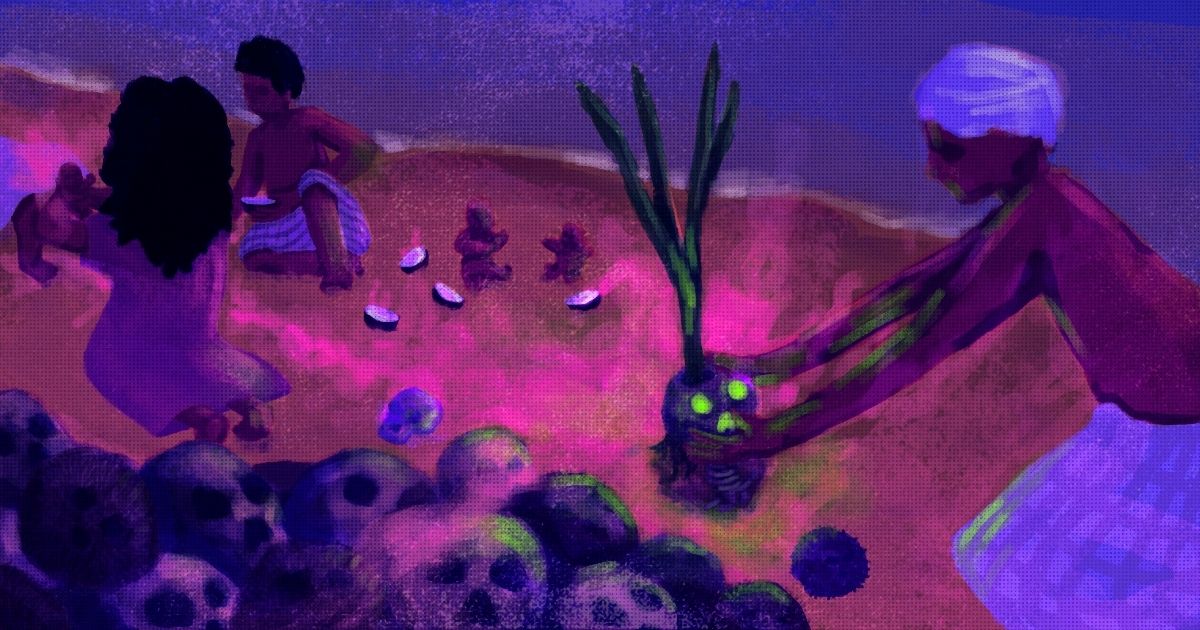
Artwork: Dosain
28 Feb, 4:00 PM
ކަޅު ވަކަރު ޗާލު
ލައްގަމުން
މަކަރު ހާލު
ކައްކަމުން
Beautiful ebony driftwood settles on the shores,
as people cook elusive roosters.
ވެލިގަލާ ޗަކަސް އަޑިން
ފަރި ކޮށް ނެށި
ހުއިފިލަނޑާ
އޮޑިކާ ބޮޑު މަސްބުރި ރިހަ
Content to feast on sperm whale curry,
A sea-cucumber danced
under the silt and sandstone.
ކާލާ ބަނޑު ދަމާލާ
މީގަދީ ރާއްޖެބާ؟
ރުއް ނެތި ފަޅު މަތި މަލަ
ނަލަ ފަންތޮށި ފެހި
It pondered,
With no coconut palms gracing the skyline,
can the Maldives be fit for future generations?
ފުޅަ ގުޅަ އެޅި
މަސްގަނޑު ފަރު ވިލު ކަނޑަށާ
ދުން ނެތި ދާ ތަރި އަލިގުޅަ
ހުން ގަދަވެފަވާ އުޑެކޭ
People starved to death daily, in such multitudes,
maggot-ridden corpses were left to drift with currents,
into lagoons, reefs, and the open ocean.
shooting stars and celestial bodies
deserted the feverish night sky.
ބުން ވެފަތިބި ބުއް ނުލިބިފަ
ކިރުމައިން ދެމިއޮތުމުގެ
އާލަމަށް ވެލި ފަސްގަނޑު
ކަށްބިން މުޅި ރަށް ތެރެއަށް
One day, all the wet nurses and mothers died, burial grounds stretched all across the island,
leaving all the infants and newborns to starve.
ކެތް ނުވި ކަންވެރިޔާއަށް
ކިޔަވާ އަނގަޔަށް ލެވި
ވަޅުލާ މަންތަރު ހެދި
ރުއް ގަސް ފަން ފަންޑިތަ މޮޅު
To save the bloodline of the first-settlers,
the great white sorcerer,
made a magic poultice
and fed a portion to the mouth
of each deceased woman.
ޅަ ކުދިންނަށް
މަންމައޭ
މި ގަހުން ކިރު ލިބިގެންވޭ
ކާށްޓާ ކުރުނބާ މިނި
Out from the buried skulls,
-brimming with young and matured coconuts-
grew the trees that became mothers
to feed the newborns.
އޮޑި ދޯންޏާ ގެވަޅަށް ފަން
ބޮޑު ބެރަކަށް ރުއް ބުޑު ކެނޑި
ކުނި ކެހުމަށް ފަތި އިލޮށި
ކަރު ކެހުމަށް ކުރުނބާ ފެން
These Maldivian mothers also gave their children
timber for building the boats,
fronds for thatching the houses,
wood for crafting the drums,
fibres for brooms to keep the island clean,
and coconut water, rich with nutrients,
to quench their thirst as they worked.
ދެން ލޯމާފާނު ގަޔާ
ފަތްތޫރަ ފޮތްތަކުގާ
އަވަހަށްލިޔެ ފަވާލާ
ކާށި ގަބުރު ބަހުރުވާ
Why don’t we write about our coconut mothers
in official publications?
Why don’t we engrave their story
on copper plate records?
Backstory:
Legend says that Maldives had no coconut trees during the time of the first settlers. Coconut trees would later become a source of supreme nourishment for Maldivans.
The settlers started dying in great numbers due to lack of food sources. A great white magician locally known as fahnn'dithaveriyaa / kahnn’veriyaa decided to resolve the food scarcity. He is said to have placed a magical mixture made out of herbs and leaves inside the mouths of the deceased before burial.
Astonishingly, out of their skulls grew coconut trees. This may be the reason why naashi means both skull and coconut shell. Hence, for Maldives, the coconut tree is said to have an anthropomorphic origin.
The coconut palm, which went on to be heralded as our national tree, gave us food and sturdy wood for our ancestors to make boats to go out and fish and sail, thatch to make houses, coir-rope for rigging sails and a myriad of other applications, firewood to keep warm, stems for making brooms for cleaning, and so on.
In writing this poem, I have added my own elements to the original myth. I state that women, specifically pregnant and recently pregnant mothers were the ones dying out of the first settlers, leaving many orphans and newborns without a viable food source. There weren't any cattle that could be milked.
The white magician knew that he had to act fast. He could not resurrect the dead. Therefore, he made an incantation to bring the mothers back as trees that would not only provide a fruit that bore milk for the newborns, but also as trees that could shelter, protect, develop and nourish the entire communal lifestyle of Maldivians for the coming generations and towards the end of time. This may very well be the reason why it became our national tree. This legend also explains why young coconuts resemble breasts. I think that this also explains why fahnn'ditha (white magic) might be derived from the word fahnn’ (palm leaves) and also why young coconuts are still used today for black magic.
Interestingly enough, coconut trees are also known as the "Tree of Life" in many parts of the world.
Dhivehi to English Translations:
ފަންޑިތަ - Fahnn'ditha = White Magic
ފަން - Fahnn' = Palm Leaves / Straight (Hair)
އިލޮށި - iloshi = Ekel / The thin nerves of the coconut palm leaves (used to make traditional Maldivian brooms)
ކާށި - Kaashi = Mature Coconut
ކަށި - Kashi = Bone
މިނި ކަށި - Mini Kashi = Human Bones
މުޑި ކާށި - Mudi Kaashi = One of the latest stages during the life cycle of a coconut
ނާށި - Naashi = Skull / Coconut Shell
Rafil Mohamed is the author of “Baburu Akuru,” a collection of contemporary Dhivehi poems with English translations, that drew inspiration from Maldivian folklore.
Discussion
No comments yet. Be the first to share your thoughts!
No comments yet. Be the first to join the conversation!
Join the Conversation
Sign in to share your thoughts under an alias and take part in the discussion. Independent journalism thrives on open, respectful debate — your voice matters.

